Landfill, compost or incineration? Waste management.
Paper for the ISWA Conference, Portugal, October 2009
by Barbara Hutton, Research student, Master of Sustainable Practice, RMIT University, Ed Horan, Program Director, Master of Sustainable Practice, RMIT University, Melbourne and Mark Norrish, Mathematics, Australian National University, Canberra (Australia)
EXECUTIVE SUMMARY
Methane (CH4) is predicted to cause as much global warming as carbon dioxide (CO2) over the next 20 years. Traditionally the global warming potential (GWP) of methane has been measured over 100 years. The IPCC’s Fourth Assessment Report (IPCC 2007) warns that this under- estimates its immediate impact. Viewed over 20 years it has 72 times the GWP of CO2.
The current study was prompted by concern about these emissions, and by a recent Government policy study in Melbourne, Australia, which recommended composting of municipal waste. Melbourne has not run out of landfill space, and has best-practice landfills with methane gas extraction. The mass composting of waste would reduce landfill gas, currently used as a fuel.
AIM OF THE STUDY
This study uses recent information (2006 IPCC Guidelines) with local data to estimate:
- How much greenhouse gas is emitted to the atmosphere from best practice landfill with methane capture pipes? How much can be captured to use as fuel?
- Is aerobic composting or incineration better at controlling emissions than landfill with gas capture ?
METHOD
A spreadsheet was set up to compare emissions of methane, nitrous oxide and anthropogenic (man-made) carbon dioxide from compost, landfill and incineration, based on IPCC figures. The IPCC model allows for differences in temperature, humidity, dryness and aeration in the landfill, and different types of organic waste. Melbourne (Australia) was used as a case study for the spreadsheet
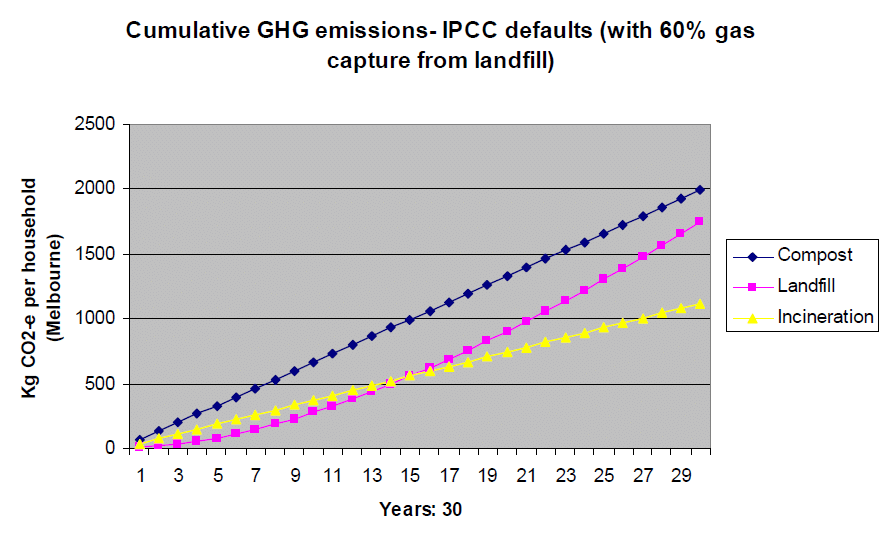
Over the next 30 years, incineration produced the least greenhouse gas emissions, followed by landfill with gas extraction. Surprisingly, aerobic composting produced the highest level of emissions. This is based on the assumption that landfill has leachate and gas capture pipes, as is now common in Melbourne, with 60% gas capture. We assumed that 10% of the escaping methane was oxidised as it passed through the soil cover, and some waste would break down aerobically before anaerobic conditions were established. IPCC estimates for CH4, N2O and anthropogenic CO2 emissions from composting and semi-continuous fluidised bed incineration, were compared with the landfill emissions.
FINDINGS
- Incineration of waste had the least climate impact of the three methods of disposal, followed by landfill with gas capture. This study did not estimate CO2 savings from waste-to-energy, only the benefits from reducing greenhouse gas emissions, CH4 and N2O, from landfill and composting. If energy-from-waste is used to replace coal-fired electricity, results for incineration and landfill gas capture would be even better.
The results supported earlier studies by Pipatti and Savolainen (1996) and the Hyder Study of waste options for Melbourne (2007). Both found that incineration was in fact the best option for reducing greenhouse gases. Anaerobic digestion of wastes for methane would work well if 100% of organic waste could be separated, but this is unlikely to happen in reality. Pipatti and Savolainen found that the second best option was landfill with CH4 used as fuel. Our study supports this finding.
- Composting does reduce the amount of waste going to landfill, as an end in itself. In the long run it may reduce GHG emissions. But initially it brings the emissions forward, meaning that climate change is accelerated. In this scenario, it takes more than three decades for greenhouse emissions from landfill to catch up with those from aerobic composting.
It is possible than in 30 years time a solution may be found to methane escaping from landfill, or that energy prices will be so high that landfill is mined as a fuel. So the predicted longer term emissions from landfill may never eventuate. Diverting organic waste to compost now, without capturing emissions from the compost, may be counter-productive, merely hastening the melting of Arctic and Antarctic ice.
CONCLUSIONS
An earlier, more detailed study of the options for Melbourne’s municipal waste, suggests that the goal of diverting waste from landfill is over-emphasised as Melbourne has adequate landfill space, and more is created by quarrying activities. The huge volume of poor compost produced if all household waste is composted may lead to a collapse in the market for compost.
- Well managed landfill with gas capture can reduce methane levels and delay emissions for decades. About 50% of the organic carbon is sequestrated and only about 5% of waste decomposes in landfill annually. Most of the methane can be captured or oxidised at the landfill site.
- There is great potential for energy generation from thermal electricity generation from municipal waste; from landfill gas and in some cases anaerobic digestion of separated waste. Spark ignition motors are currently used to convert methane to electricity, but fuel cells, cogeneration of energy and heat, and direct use of methane are all possible.
- Municipal waste should not be routinely composted before disposal, and certainly not in open air windrows. Landfill with gas capture is a better option for reducing emissions, and producing bio-fuel.
- Home composting bins may produce more greenhouse gas per unit of waste than landfill.
- Compost can play an important role in Australia, especially in organic farming and as tip cover, to oxidise escaping methane, but high quality compost from separated organics is best for
both purposes. The priority is to compost rural and animal wastes which currently do not go to best practice landfill and may be releasing large quantities of CH4 and N2O.
BACKGROUND: MELBOURNE MOVES TO DIVERT ORGANIC WASTE FROM LANDFILL TO COMPOST
In Melbourne, the Metropolitan Waste Management and Resource Recovery Strategy (MWMS 2008) examined several options for solid waste management in 2008 and produced a policy this year.
Melbourne households are already supplied with two bins, one for recyclables (bottles, cans, plastics, paper) and another for residual waste. Suburban households often have a third bin for garden waste. Australia has a policy of minimising waste to landfill. A study of residual waste in 2005-6 found that 41% was food waste, 18% green waste and 6% paper – all organic waste which could be composted.
The MWMS plan considered options for diverting organic waste from landfill, including composting residual waste in large-scale Advanced Waste Treatment composters (AWTs); separating organic waste for aerobic or anaerobic composting, and thermal power from waste.
Hyder Consultants (Hyder 2008) were employed to carry out a study. They found thermal electricity generation performed best in all areas, even reducing air pollution because it would replace highly polluting brown-coal-fired energy, which is the current source of Melbourne’s electricity. Burning the waste would also reduce GHG emissions by eliminating methane from landfill. However it rejected the option of incineration because of community concerns and difficulty in siting the incinerators.
Compost: it found anaerobically digested, separated wastes produced the best compost, and produced 80-100kWh of energy for every tonne of waste. But not all organic waste would be removed from landfill; there would still be methane gas escaping. The MWMS study therefore favoured Advanced Waste Treatment, with all residual waste including garbage composted. This produces stabilised landfill and poor quality compost. A submission from Boral, the managers of Melbourne’s Western Landfill (Boral submission 2007) and also involved in composting at the Pine-Gro composting plant, suggested the compost from mixed residual waste would be unsalable, and would probably go to landfill. Anaerobic treatment of mixed residual waste is difficult because of contaminants (Fulhage, 1993). The Hyder study found it would produce no net energy and in fact slightly cost in energy.
MEASURING METHANE FROM LANDFILL, COMPOSTING AND INCINERATION
Our present study aims to objectively compare the options for waste disposal. It uses the United Nations Framework Convention on Climate Change (UNFCCC/CCNUCC) “Tool to determine methane emissions avoided from disposal of waste at a solid waste disposal site”, version 4, 2008 (“the tool”) to compare methane generation from landfill versus aerobic composting and GHG emissions from incineration. Equations and background information from the 2006 IPCC “Guidelines for National Greenhouse Gas Emissions”, Vol. 5 “Waste”, Chapters 2 – 5 and Vol.2, “Energy” were also used.
The following factors are used to calculate methane emissions:
- Quantity of organic waste deposited in landfill each year, per household.
- Fraction of degradable organic carbon in the waste (averaged over its various components)
- Fraction that actually converts to methane. Only about half of this matter ever decomposes, and of this, only half converts to methane.
- The conversion factor from carbon to methane.
- The rate of accumulation of waste in the landfill, and the rate of decomposition of waste.
- Methane captured from landfill for flaring or fuel.
- “Methane correction factor”: Some organic material decomposes aerobically due to oxygen inside the landfill: less if it is wet and anaerobic, more if it is well managed and dry.
- Some methane oxidises on its way out, if the site has a soil or compost “biocap” cover.
Altogether, only a very small amount of potential methane escapes from best practice landfill, and it is produced very slowly, as the decomposition rate in a dry temperate climate is only about 5% per year. Aerobic composting produces mostly CO2, but also releases a small amount of methane (the IPCC default estimate is 4 grams of methane per kilogram of organic waste).
Incineration produces mostly CO2. Open burning of waste does produces CH4 but continuous fluidised bed incineration produces none at all. In this study it is assumed that semi-continuous fluidised bed incineration is used – this produces CH4 and N2O which have been taken into account in calculating emissions.
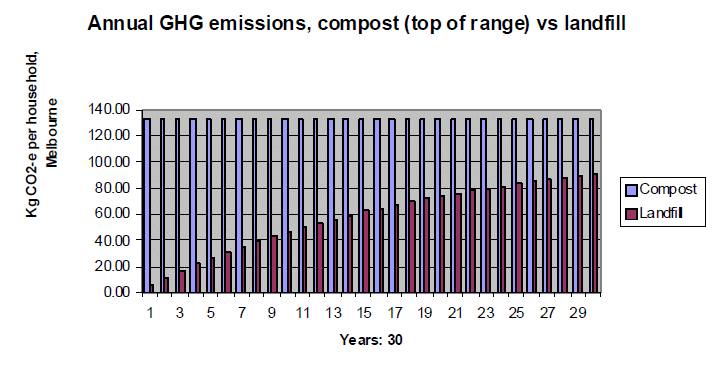
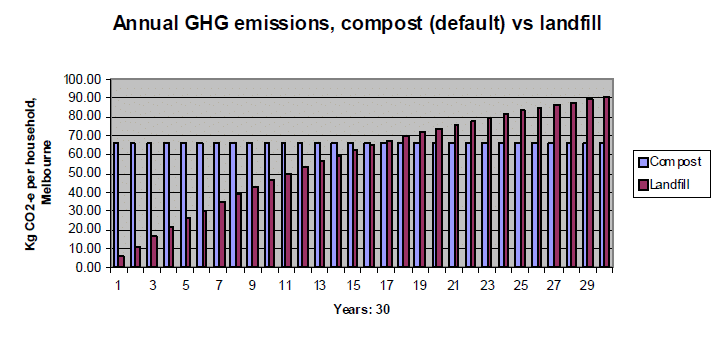
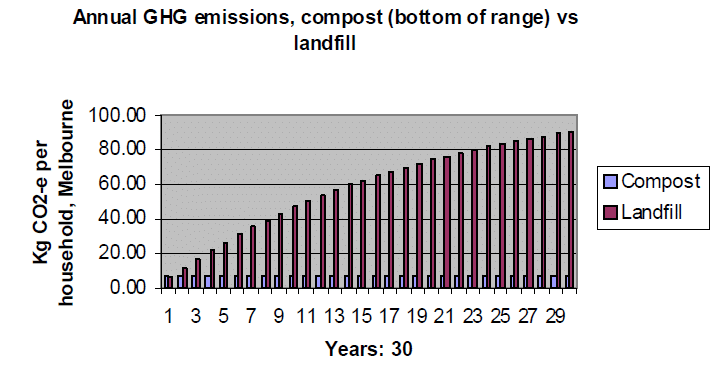
The top chart shows maximum expected GHG emissions for managed composting. These are likely to be found in a warm climate, where compost is kept wet. The second chart shows the IPCC default value for compost. The third shows minimum values, probably inapplicable to Australia. Much of the IPCC’ referenced data is from Scandinavia and Finland where it is very much colder than Australia and so little methane is produced.
Methane and N2O emissions from poorly managed composting may be even higher than those shown in the top graph. Bert Metz (2007 IPCC) points out “CH4 and N2O can both be formed during composting by poor management and the initiation of semi-aerobic (N2O) or aerobic (CH4) conditions; recent studies also indicate production of CH4 and N2O in well-managed systems (Hobson et al 2005).”
A small but disturbing study from the Griffith University, Queensland, Australia (the Insinkerator study, 1994) compared household composting systems with sink disposal units and landfill. Very high levels of methane were found in unmanaged household compost bins.
ASSUMPTIONS ON METHANE CORRECTION FACTOR IN LANDFILL
The above graphs assume a methane correction factor (MCF) of 0.6 for landfill, i.e. it is 60% anaerobic. The IPCC recommends this value if it is not known how the waste is managed. If waste is unmanaged in a shallow tip, the MCF value is 0.4, as much of the waste will degrade aerobically. If the waste is buried deep or the water table is a high, e.g. if it is dumped in a swampy area, a value of 0.8 is used. If it just compacted or levelled and covered, the MCF is 1.
In the 1996 IPCC Guidelines, all managed waste was assumed to be 100% anaerobic (an MCF of 1). This was a heroic assumption. It requires only very low levels of oxygen in the waste to produce some aerobic decomposition, especially before anaerobic conditions are established in the waste (see Metz, IPCC 2007). A recent Swedish study (Smars, Sven and Beck-Friis 2002) found some aerobic decomposition in waste was still occurring at 1% oxygen levels.
In the 2006 IPCC guidelines a new category of semi-anaerobic landfill has been introduced with an MCF of 0.5. This type of landfill has leachate drainage, gas capture, ventilation and permeable cover. In Melbourne, landfill sites typically have leachate drainage and gas capture. It is uncertain whether the tip cover is permeable. (It is not intended to be, yet it is estimated that 40% of the methane escapes through it.) The subsoil is extemely dry, relative to Europe and Scandinavia. This would tend to allow oxygen to penetrate.
Further studies are required to establish how much decomposition occurs before landfill conditions become anaerobic, how much oxygen is found in landfill gas and what the real MCF is in Melbourne. The Australian Government Department of Climate change still classifies all landfill in Australia as 100% anaerobic on the grounds that it is “managed”. This follows the classification in the now superseded 1996 IPCC Guidelines. More up-to-date estimates are needed.
WHY DO THE RESULTS SHOW HIGHER EMISSIONS FOR COMPOST RELATIVE TO LANDFILL AND INCINERATION THAN ARE GENERALLY ASSUMED?
Much of the widespread understanding of GHG emissions from landfill, compost and incineration is based on early modelling in the 1996 IPCC Guidelines. Since then it has been discovered that:
- composting does release CH4 and N2O. A range of estimates has been provided.
- landfill is not always 100% anaerobic but can be semi-anaerobic, with an MCF of 0.5.
- much organic material in waste does not degrade under anaerobic conditions. The 2006 IPCC advises that only 50% at most will decompose in landfill. Of this, only about 5% of decomposable organic waste decomposes each year.
- a “First Order Decay model” has been introduced to account for the slow decay of waste in landfill: Earlier models erroneously assumed that decomposition all occurred in the first year.
ASSUMPTIONS ON CARBON STORAGE, GAS CAPTURE AND GAS OXIDATION IN TIP COVER
The 2006 IPCC Guidelines’ assumption of 50% carbon storage in landfill is conservative. The IPCC also conservatively assumes that only 10% of methane is oxidised in soil or compost cover of landfill: the USEPA (2002) puts it at 70-85%. Finally our study assumes 60% of landfill gas is captured but Metz (IPCC 2007) states that gas capture may be 90% or more.
There are still many unknowns but assumptions in this study are probably conservative.
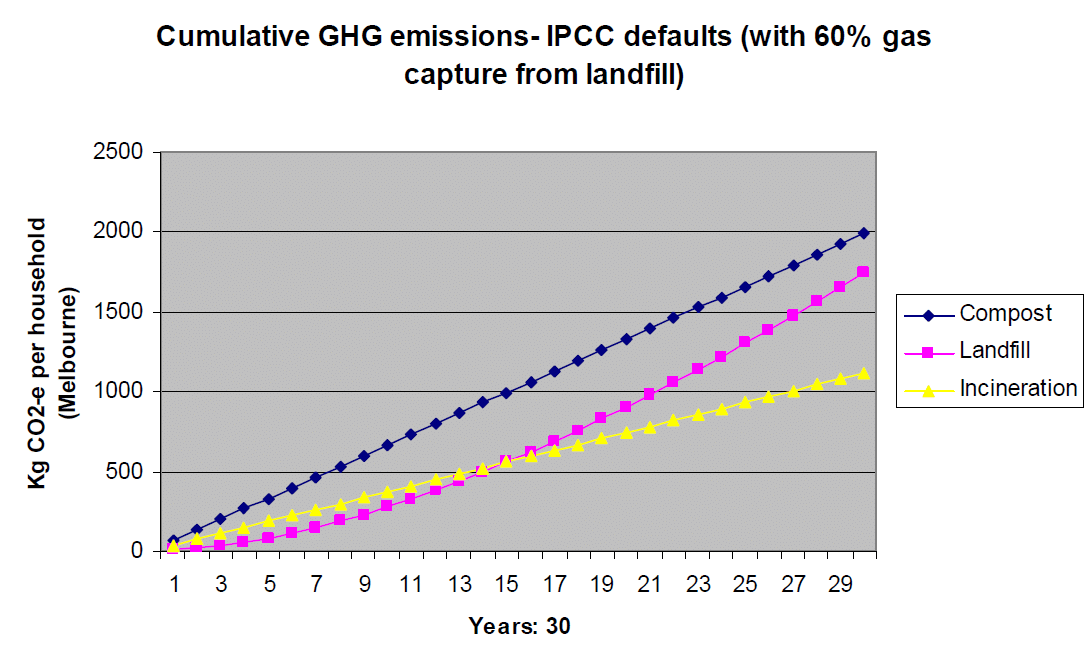
Incineration produces the least GHG. According to the Hyder report 2007 it would also produce less of other kinds of air pollution and more green energy than other options.
Note that the IPCC considers only CO2 from burning fossil-fuel based wastes to be anthropogenic (man-made). CO2 produced from burning organic waste is not counted. It would occur anyway in nature, whether the waste material oxidised slowly in decomposition or quickly in burning. CO2 emissions from composting and landfill are also not counted. As the global warming potential of methane and nitrous oxide is much greater than that of CO2, including non- anthropogenic CO2 would make little difference to the results.
FINDINGS
- For about the first 30 years, under the assumptions used in our study, aerobic composting releases greenhouse gas (GHG) more quickly than landfill, meaning that climate change is accelerated. Possibly in 30 years, energy prices will be so high that landfill is mined as a fuel, or better methods of containing CH4 in landfill will be developed. So the predicted longer term emissions from landfill may never eventuate. Diverting organic waste to compost now may be counter-productive, merely hastening global warming.
- Incineration produces the least man-made GHG emissions of all methods of waste disposal. The Hyder study of Melbourne’s waste (2007) found the same thing. In some Scandinavian countries, thermal waste-to-energy has been part of national energy since the 1970s global energy crisis (Bateman 2006). A study by Dr Riitta Pipatti, leading author of the 2006 IPCC Guidelines Vol. 5, “Waste”, and I. Savolainen (1996) found that mass incineration was the best option and that composting released more emissions than landfill with gas capture
